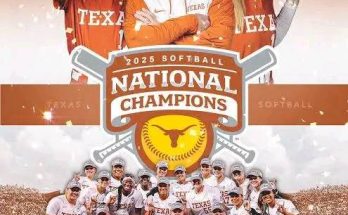Caitlin Clark and Lexie Hull, two of women’s college basketball’s brightest stars, recently caught the attention of basketball fans not just for their stellar play on the court but for a curious choice of attire that sparked intense speculation. At the highly anticipated Game 6 of the NBA Finals, both Clark and Hull were spotted rocking Indiana Pacers gear, a sight that seemed more than coincidental given their prior connections and the ongoing questions swirling around the Indiana Fever’s future. This moment has fans and analysts alike wondering: could this be a subtle hint of decommitment or distancing from the Fever, the WNBA franchise based in Indiana, or is it simply a gesture of support for the state’s basketball culture? The implications of their appearance in Pacers apparel open a fascinating discussion about player allegiance, professional futures, and the evolving landscape of women’s basketball in Indiana.
Caitlin Clark, a standout guard known for her dazzling scoring ability and court vision, and Lexie Hull, a sharpshooting wing with a reputation for clutch performances, have both been closely linked to the Indiana Fever in the context of the WNBA draft and professional aspirations. Clark, widely considered one of the most electrifying players in college basketball, has been a projected top pick for the Fever, with many expecting her to become a franchise cornerstone. Similarly, Hull’s consistent excellence and leadership have made her a highly coveted prospect, generating buzz about a potential future in Indiana’s professional women’s basketball ranks. Their mutual presence at a marquee NBA Finals game donning the gear of Indiana’s NBA team, however, raised eyebrows for reasons that go beyond fan enthusiasm.
The Indiana Fever, once a flagship WNBA franchise known for producing legends like Tamika Catchings, have struggled in recent years with performance, fan engagement, and organizational stability. Rumors and reports about possible shifts in ownership, relocation, or even operational pauses have circulated within basketball circles, leaving players and fans uncertain about the franchise’s trajectory. In this context, Clark and Hull’s choice to publicly showcase Indiana Pacers apparel—representing the NBA’s men’s team, which shares the same home state and fanbase but operates under a different brand and organizational structure—could be interpreted as a subtle distancing from the Fever brand or a signal of frustration with the current state of Indiana’s WNBA representation.
Some fans and commentators argue that Clark and Hull’s visible support of the Pacers is simply an embrace of Indiana basketball pride. After all, the Pacers remain a prominent and competitive franchise in the NBA, with a passionate fanbase that spans the entire state. Wearing Pacers gear to a high-profile NBA Finals game could just be a celebration of Indiana’s rich basketball heritage, especially as the Fever have struggled to capture similar attention and success. This interpretation suggests that the gesture is less about decommitment from the Fever and more about honoring the broader basketball culture that has nurtured both players from their youth through their college careers.
However, the timing and setting of the appearance give weight to the alternative perspective. Game 6 of the NBA Finals is a moment when basketball eyes are focused nationally, and athletes’ choices—whether in gear, words, or social media posts—are dissected for hidden meanings. For two women who are poised to make pivotal career decisions, publicly aligning themselves with a franchise that is stable and thriving (the Pacers) rather than one facing uncertainty (the Fever) may be a strategic move. It could be a quiet message to stakeholders, signaling that their future plans might not hinge on the Fever’s fortunes, especially if questions about the team’s viability continue unresolved. This potential quiet decommitment might be a way for Clark and Hull to keep their options open as they approach the professional phase of their careers.
This moment also reflects a larger conversation happening across women’s professional basketball, where players are increasingly vocal and active in shaping their careers amid shifting landscapes of team stability, market visibility, and league investment. The Fever’s challenges mirror those of other WNBA franchises grappling with financial and organizational hurdles, while the NBA and its affiliates maintain far greater resources and visibility. By wearing Pacers gear, Clark and Hull may be drawing attention not only to Indiana basketball but also to the discrepancies in support and opportunity that women players face—even those as talented and marketable as themselves. Their apparel choice could be interpreted as a subtle call for greater investment in women’s basketball in Indiana, or a signal of their intent to leverage their brand in ways that transcend traditional franchise affiliations.
It’s worth noting that neither Clark nor Hull has publicly commented on their intentions regarding the Indiana Fever since the NBA Finals game. Without explicit statements, all interpretations remain speculative. Yet, the optics of the moment are powerful. For Indiana basketball fans hoping to see these stars grow the Fever’s legacy, the sight of them embracing Pacers gear may be bittersweet—a reminder of the ongoing challenges within women’s professional basketball locally, even as the state celebrates success at the NBA level. For the broader basketball community, it highlights how intertwined player identities are with team brands and how symbolic gestures, such as apparel choices, can ripple into conversations about loyalty, opportunity, and the future of the sport.
Moreover, the Fever’s situation calls attention to the necessity for WNBA franchises to build strong, visible, and well-supported brands that can compete for talent and fan devotion in a crowded sports market. The Fever have a proud history but must navigate an increasingly competitive environment where young stars like Clark and Hull have options and voices. If the Fever want to retain and attract such talent, they will need to address organizational uncertainties and demonstrate a clear, stable vision for their future. Players, in turn, are rightfully mindful of these dynamics as they contemplate their professional paths.
In the meantime, Caitlin Clark and Lexie Hull’s Indiana Pacers gear moment at the NBA Finals stands as a subtle but intriguing chapter in the unfolding story of women’s basketball in Indiana. Whether it signals a quiet decommitment from the Fever or is merely a celebration of the state’s basketball culture, it has sparked a conversation about player allegiance, franchise futures, and the evolving landscape of professional opportunities. As these two stars prepare to transition from college icons to professionals, their choices will continue to captivate fans and shape the narrative of basketball in Indiana and beyond.
Ultimately, this incident reminds us that athletes’ expressions of identity—through apparel, public appearances, and affiliations—carry weight far beyond the surface. They reflect personal values, career strategies, and sometimes, subtle signals about the sports ecosystems they inhabit. For Indiana basketball, the message from Clark and Hull is a prompt to reflect on how the state supports its basketball stars, especially women, and how those stars in turn navigate the complex realities of their professional futures. Whether this is the beginning of a shift away from the Fever brand or simply a nod to the broader Indiana basketball family, it is a moment worth watching as the basketball world continues to evolve.



